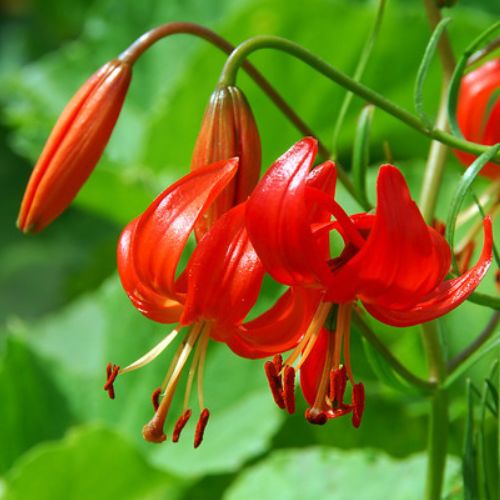We've seen countless gardeners struggle when selecting the right lilies for gardening, resulting in average blooms and wasted effort. Our lily planting tips, seasonal care advice, and design inspiration can help you avoid this dilemma. Here’s a list of the best native lilies to grow in a garden that will flourish for years to come.
Best Native Lilies to Grow in a Garden
Based on regional classifications, the best native lilies to plant are those that are naturally adapted to your specific geographic area. Examples include Prairie and Turk's Cap lilies for the East Coast, Leopard and Humboldt lilies for the West, and Gray's and Carolina lilies for the South. Selecting native lilies ensures they’re well-suited to the local climate and soil conditions, promoting healthier growth and supporting native ecosystems.

Here are some of the most popular true native lilies of the U.S. Most of these can be found in full sun to partial shade conditions. They enjoy the protected sun and find relief from the afternoon sun under the forest canopy.
|
Classification |
Examples |
|
East Coast native lilies |
Prairie, Michigan, Canada, Turk's Cap |
|
Southern native lilies |
Gray's, Carolina, Catesby's, Pot-of-Gold |
|
Western native lilies |
Columbia, Leopard, Humboldt, Kellogg's, Lemon, Washington |
|
Nativars and American Hybrid lilies |
American Spirit, Lake Tulare, Cherrywood |
Best Native Lilies for the East Coast
Native lily species in Eastern America thrive due to the region's diverse habitats, including moist woodlands and meadows, which provide the necessary cool, shaded, and well-drained soil conditions many lilies prefer.
1. The Prairie or Wood Lily (L. philiadelpicum)
Prairie lily is native to much of the upper Midwest and Eastern America. It is an upright lily and easily identified because of that. It can be found in meadows, prairies, and forest edges, where it can get full sun to partial shade.
2. Michigan Lily (L. michiganense)
A widespread lily in the Midwest, the Michigan lily is very hard to propagate. It can take two years for the seed to germinate under natural conditions, regardless of whether it is exposed to full sun or partial shade. This lily with unscented orange to red-orange flowers is happy with some wet soil and can be found near streams.
3. Canada Lily (L. canadense)
Canada lilies are excellent native plant choices due to their adaptability to partial shade and their beautiful, nodding, trumpet-shaped flowers that attract pollinators. Their preference to naturalize in woodland gardens makes them a low-maintenance plant, letting them grow in Montana, Wyoming, North Dakota, South Dakota, and down as far south as Georgia and South Carolina.
4. Turk's Cap Lily (L. Superbum)
Turk's Cap lilies are excellent native lilies due to their striking display of numerous, downward-facing flowers with dramatically recurved petals. Their adaptability to a range of conditions makes them a valuable and beautiful addition to native plant gardens.

Best Native Lilies for the South
Some native lily species thrive in the South's warmer, often humid climate, as well as in specific soil types found in habitats such as open flatwoods and seasonally moist areas.
1. Gray’s lily or the Roan Lily (L. grayi)
Gray's lily thrives in acidic and loamy soils, which is why it's an excellent native plant for North Carolina, Virginia, and Tennessee. Its nodding, bell-shaped crimson flowers provide a unique and beautiful display in its native habitat.
2. The Carolina Lily (L. michauxii)
The Carolina lily is a superb native lily to plant in sandy soils. Its striking, downward-facing orange flowers are a delightful sight in North Carolina, Virginia, South Carolina, Florida, Georgia, Alabama, Mississippi, Louisiana, and Texas.
3. Catesby’s lily or Leopard Lily (L. catesbaei)
Catesby's lily is well-suited for the moist, acidic, sandy soils of Florida, Louisiana, Georgia, Alabama, Virginia, Mississippi, North Carolina, and South Carolina. Whether it's full sun or partial shade, this native plant will bloom upright, cup-shaped flowers with orange petals.
4. Pot-of-Gold Lily or Panhandle Lily (L. iridollae)
The Pot-of-Gold lily loves the piney forests in Alabama, Mississippi, and Florida. It adapts well to the moist, acidic soils of seepage slopes and pitcher plant bogs.
Best Native Lilies in the Western Half of the United States
Native lilies in western America have adapted to the region's varied environments, from coastal fog belts with specific soil compositions to higher-elevation meadows with distinct moisture regimes.
1. Columbia Lily (L. columbianum)
The Columbia lily resides in the Pacific Northwest due to its adaptability to the moist, well-drained soils and dappled shade found in woodlands and meadows of the region. It features bright orange, nodding flowers with maroon spots.
2. Leopard lily or California Tiger Lily (L. pardalinum)
Native throughout much of the Pacific Northwest, Leopard lilies love moist soils and are often found near streams and other bodies of water. Full sun to partial shade helps produce striking, downward-facing orange to red flowers with recurved petals and prominent spots.
3. Humboldt Lily (L. humboldtii)
Found in southern California, the Humboldt lily is a magnificent native plant to California, particularly in the foothills and lower mountains, where it appreciates well-drained soil and some shade. Its tall stems bearing numerous large, orange to reddish-orange flowers with dark spots create a spectacular display in its natural Western environment.
4. Kellogg's Lily (L. kelloggii)
Found in northern California and Oregon, Kellogg’s lily is predominant in redwood forests. A beautiful native of northern California and southern Oregon, Kellogg's lily adapted to the drier conditions of coniferous forests and chaparral. Its delicate beauty is showcased by nodding white to pink flowers with purple spots.
5. Lemon Lily (L. parryii)
The Lemon lily is found in the American Southwest because it thrives in high-elevation meadows and moist areas of the southern Sierra Nevada and parts of Southern California. Its fragrant, bright yellow flowers are well-suited to the cooler temperatures.
6. Washington Lily - (L. washingtonianum)
The Washington lily is a fragrant and elegant native found in Oregon and California. This lily was named after Martha Washington, George Washington’s wife. Its pure white, trumpet-shaped flowers thrive under full sun to partial shade and well-drained, often rocky soils in open forests and meadows.
Popular Nativars and American Hybrid Lilies
Popular Nativars and American Hybrid Lilies are found in many nurseries and specialty retailers. Thriving in full sun to partial shade, they showcase unique characteristics derived from North American native species, often showcasing downward-facing flowers and adaptability to woodland garden settings.
1. American Spirit
As a hybrid derived from native North American species, Spirit of America offers a beautiful and resilient option for gardeners seeking to support native plant genetics in their landscapes. It has prominent tricolor flowers, creamy white with a reddish-pink center star, and a golden center.
2. Lake Tulare
Lake Tulare is a popular nativar appreciated for its Turk's cap flowers that are pink with yellow towards the center. As a hybrid, it offers a unique aesthetic while often retaining good adaptability to similar growing conditions, even when propagated at home.
3. Cherrywood
Cherrywood is a well-regarded American hybrid known for its rich, deep cherry-red flowers that bring a luxurious and intense color to the garden. Its sturdy stems and reliable blooming make it a popular selection for adding a touch of drama and sophistication to landscapes.
Related Questions
What Is a Native Lily?
A native lily is found here in the wild, while a nativar is a cultivated lily that has been selected for specific reasons. If you are looking for flowers for a woodland garden or natural area, then searching for true native lilies or native lily nativars may be a good match for you.
What Are the Easiest Lilies to Grow?
True lilies like the Asiatic lily are among the easiest to grow, thriving in full to partial shade and requiring minimal maintenance compared to other lily varieties. Tiger lilies and Trumpet lilies are also excellent choices for beginners as they are hardy, disease-resistant, and produce stunning blooms with proper care.
How Can I Plant and Care for Native Lilies?
Native lilies, unlike other lilies, should be planted in their preferred habitat conditions of full sun to partial shade, with well-draining soil that mimics their natural environment. These beautiful flowering plants require consistent moisture, minimal fertilization, and protection from aggressive competition with other garden species.
Conclusion
With this exhaustive list of the best native lilies to grow in a garden, you can create a breathtaking green space with thriving blooms. True lilies and other lilies native to your region will reward you with years of sublime beauty while requiring less maintenance.


